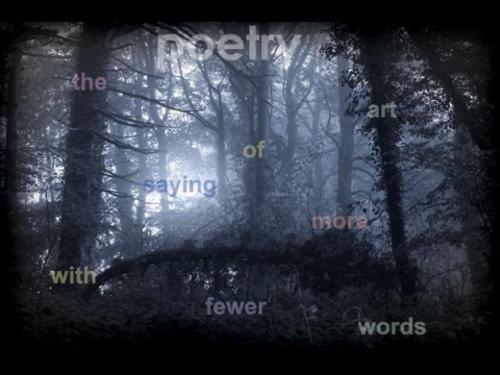Poetry: How To Write a Better, More Creative Poem
If you’re a writer, then at some point you must have had tried writing poetry. Have you written a poem? Who says you can’t write a poem? Anyone can learn how to write a poem.
How To Write a Better, More Creative Poem
You can try these poetry strategies:
- Brainstorm. Choose a theme and a sort of ‘thesis' for your poetry. Determine the best style, or form of poetry you would be using - A free-verse? How about a sonnet? Formulate a plot or succession (unless you already are an expert in free writing).
- Use the Simple Present Tense. Using this sentence tense often eliminates minimal words in writing poetry.

- Photo Credit: Marcus Edward John Cross
- Write in a narrative approach. Story-tell. Craft a poem that is nearer to your heart.
- Be certain to use remarkable imagery. Set the scene and weave vivid descriptions. Let your poetry be seen.
- Apply the Figures of Speech:
- Simile. Make simple comparisons using the words ‘like' or ‘as...' or more stylish comparison phrases as ‘similar to,' ‘akin to,' ‘resembling,' ‘in the vein of,' or ‘reminiscent of.'
- Metaphor. Create comparisons without using the words ‘like' or ‘as...as' or other comparison words.
- Metonymy. Substitute a word for another word. For instance, "The crown failed."
- Personification. ‘Personify' or portray objects or animals as if they possess characteristics typical only of persons.
- Hyperbole. Exaggerate. "Make a mountain out of a molehill. "
- Allusion. Cite well-known literary events or prominent figures.
- Paradox. Form contradictory lines.
- Oxymoron. Construct incongruous statements using unseemly adjectives or nouns.
- Maintain the classic "Art of Poetry" elements:
- Rhythm and Meter. Create cadence in writing poetry. Arrange the number of syllables used per line.
- Rhyme. Use homonyms or words with same sounding end-syllables at the end of the lines.
- Onomatopoeia. Let your readers hear your poem. Write some sounds.
- Alliteration. Favor some words with the same first letters.
- Recurrence of words. Reiterate a word or words all throughout your poem.
- Repetition of lines. Repeat lines consecutively or non-consecutively.
- Feature the other senses of the body. Manifest sensations of taste, smell, and touch.
- Lastly, be inspired.
Now write!
What did you think of this tutorial?
+ 7
6 CommentsAdd a Comment
http://www.nikeshoes.us.org/ Nike Shoes
http://www.nfl-jerseys.us.org/ NFL Jerseys
http://www.nikeoutletonlineshopping.us/ Nike Outlet Online
http://www.nike--outlet.us/ Nike Outlet
http://www.nikeoutletonlineshopping.us/ Nike Outlet Online
http://www.travisscottjordan1.us.com/ Travis Scott jordan 1
http://www.yeezy350.us.com/ Yeezy 350
http://www.adidasyeezy.us.com/ Adidas Yeezy
http://www.yeezy-shoes.in.net/ Yeezy Shoes
http://www.yeezys.me.uk/ Yeezy Shoes
http://www.yeezy-350.org.uk/ Yeezy 350
http://www.yeezy350.org.uk/ Yeezy 350
http://www.yeezys.us.com/ Yeezy
http://www.yeezy.com.co/ Yeezy
http://www.yeezy700.org.uk/ Yeezy 700
http://www.yeezyboost350v2.de/ Yeezy Boost 350 V2
http://www.adidasyeezy.de/ Adidas Yeezy
http://www.nikeoutletstoreonlineshopping.us/ Nike Outlet Store Online Shopping
http://www.jordan11-concord.com/ jordan 11 concord
http://www.yeezy-shoes.in.net/ Yeezy Shoes
i have wrote two poems about losing my dog and it came straight from my heart. here is just a snippet of what i wrote. i would like to get it published.
this is not wat i wanted
then what did you want
This is excellent. Thank you for these tips.
Monica.
This is excellent. Thank you 4 these tips.
Monica.




